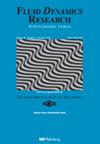The wake of a rectangular flat plate
IF 1.3
4区 工程技术
Q3 MECHANICS
引用次数: 0
Abstract
The mean wake of a three-dimensional surface-mounted rectangular flat plate was studied experimentally in a low-speed wind tunnel for four different aspect (height-to-width) ratios, AR = 3, 2, 1, and 0.5. The Reynolds number based on the plate width was Re = 3.8 × 104 and the boundary layer thickness on the ground plane, relative to the plate width, was δ/W = 1.1. The incidence angle of the plate was varied from α = 0° (where the plate is normal to the flow) to α = 90° (where the plate is parallel to the flow). The mean velocity and vorticity fields in the wake were measured using a seven-hole pressure probe. At α = 0°, the length of the recirculation zone behind the plate becomes progressively shorter as the aspect ratio is lowered and follows the same tendency as that of a finite square prism. The wakes of the slenderer flat plates of AR = 3 and 2 are characterised by two pairs of streamwise vortices: a pair of tip vortices in the upper wake and a pair of ground-plane vortices on the lower edges of the wake. With increasing incidence angle, a single tip vortex comes to dominate the wake, secondary vorticity is induced at various locations, a ‘traffic light’ vortex pattern may form, and ultimately a familiar wing-tip (trailing) vortex develops. In contrast, flow downstream of the less slender flat plates of AR = 1 and 0.5 is characterised by a single pair of large streamwise vortices, which become asymmetric with increasing incidence. Close to the flat plate of AR = 0.5, and at small incidence angles only, a unique pair of small inner vorticity concentrations, of opposite sense of rotation to the main streamwise vortices, is found in the upper part of the wake.矩形平板的尾流
在低速风洞中对四种不同纵横比(高宽比)的三维表面安装矩形平板的平均尾流进行了实验研究,AR=3、2、1和0.5。基于板宽度的雷诺数为Re=3.8×104,相对于板宽度,地平面上的边界层厚度为δ/W=1.1。板的入射角从α=0°(板垂直于流)到α=90°(板平行于流)不等。尾流中的平均速度场和涡度场是用七孔压力探针测量的。在α=0°时,随着纵横比的降低,板后再循环区的长度逐渐变短,并遵循与有限方棱镜相同的趋势。AR=3和2的细长平板的尾流由两对流向涡流表征:尾流上部的一对尖端涡流和尾流下部边缘的一对地平面涡流。随着入射角的增加,单梢涡流开始主导尾流,在不同位置产生二次涡度,可能形成“红绿灯”涡流模式,最终形成熟悉的翼尖(后缘)涡流。相反,AR=1和0.5的较不细长平板下游的流动以一对大的顺流涡流为特征,这些涡流随着入射角的增加而变得不对称。在AR=0.5的平板附近,仅在较小的入射角下,在尾流的上部发现了一对独特的小内涡浓度,其旋转方向与主流向涡相反。
本文章由计算机程序翻译,如有差异,请以英文原文为准。
求助全文
约1分钟内获得全文
求助全文
来源期刊

Fluid Dynamics Research
物理-力学
CiteScore
2.90
自引率
6.70%
发文量
37
审稿时长
5 months
期刊介绍:
Fluid Dynamics Research publishes original and creative works in all fields of fluid dynamics. The scope includes theoretical, numerical and experimental studies that contribute to the fundamental understanding and/or application of fluid phenomena.
 求助内容:
求助内容: 应助结果提醒方式:
应助结果提醒方式:


